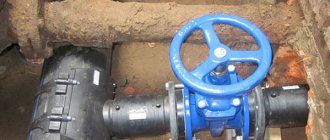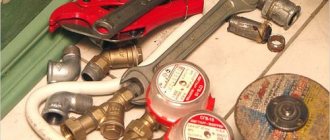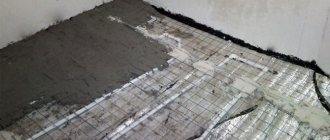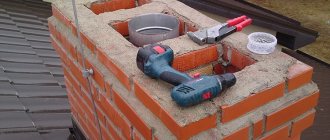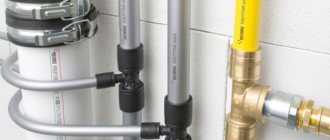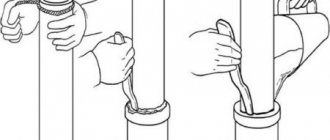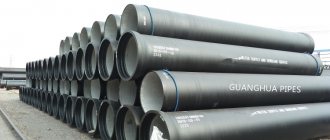If you are deciding how to connect a cast iron sewer pipe to a plastic one, you need to consider all possible methods. Metal communications are used for a long period, but sooner or later they need to be changed. Sometimes only a section of pipe needs to be updated. This method has its drawbacks, because Cast iron and plastic are characterized by different properties. When choosing a suitable method, you should take into account the state of communications and the availability of free access to pipes. All actions must be carried out in accordance with SNiP.
Connecting a cast iron sewer pipe with a plastic one
Preparatory work
The connection of cast iron and plastic sewer pipes is carried out in stages. First you need to prepare your workplace. Free up space in the area where repairs will be carried out. It is necessary to determine the type and quantity of components for installation. Most often, 2 standard sizes are used: 50, 110 mm. If you plan to change the sewer pipe in the toilet, use the second option. Communications with a diameter of 50 mm are installed in the bathroom.
At the next stage, the number of knees is calculated. A straight pipe is installed in an open area. If the room is small or there are incoming elements that interfere with the installation of communications, turns of 45-90° are provided. Their number varies depending on the configuration of the room. However, the more bends are installed, the more difficult the outflow of the sewer system becomes. You should not install more than 2-3 similar elements. Before starting work, it is necessary to shut off the water riser.
Removing cast iron pipes
Prepare the following tools:
- an angle grinder (angle grinder), it is called a grinder;
- hammer (rubber or mallet).
Cast iron communications are fragile, so you need to work with them carefully. If you remove a section of pipes with a hammer, you can damage the pipeline that is planned to be connected to plastic products. There is a high probability that pieces of cast iron will fall into the opening of the riser and a difficult-to-remove blockage will form. For this reason, it is better to use an angle grinder. The cuts will be smooth, making it possible to connect a plastic pipe.
There is no need to remove the bell during dismantling. Thanks to this structural element, it will be possible to obtain a reliable connection. After removing a section of the pipeline, the cut is cleaned. It is necessary to remove the remains of the cement mortar that is used when installing cast iron communications. Additionally, attention is paid to rusted areas. All contaminants are removed from the pipe cavity, the internal and external surfaces are cleaned and wiped dry. If you plan to use silicone sealant, the products at future joints are additionally degreased.
Pipe joining methods
There are several main methods that are used when installing a pipeline:
- socket, connection of sewer pipes, most often performed in this way;
- welded - characterized by maximum strength and tightness compared to others;
- threaded - threaded fittings are used;
- flanged;
- using press fittings;
- use of clamps.
Socket connection
Briefly, this method can be described as follows: the end of one pipe is inserted into the extension at the end of another section of the pipeline, and the connection is additionally sealed with sealant. The socket contains a sealing ring that deforms and guarantees the tightness of the joint.
Socket joint arrangement diagram
The connection of plastic sewer pipes is almost always done in this way. The sewage system in the house operates in a free-flow mode, so a socket connection is quite sufficient.
Sewage installation
Separately, it is necessary to mention the polypropylene pipeline (although it is, as a rule, not used for sewerage installation); a socket joint is also used here, but before this the material is heated.
Due to exposure to high temperatures, polypropylene softens, and the joint is completely sealed. Thanks to this, it can withstand high coolant temperatures and pressure in the system.
Sequence of actions when soldering a PP pipeline
Connection of plastic and cast iron
People are faced with the question of how to connect a cast-iron sewer pipe with a plastic one when they have to replace part of an old cast-iron, rotten sewer. A socket connection is also used here, and the main feature is that it is necessary to use a rubber cuff to seal the joint.
Plumbing cuff
After the socket is cleared of the remnants of the fill and sealant, its walls are coated with sealant, then a rubber ring is inserted into it, and only then the end of the plastic pipe. At this point, the connection between the cast iron sewer pipe and the plastic one can be considered complete.
The difference in diameters is compensated by a rubber cuff
Note! Before inserting the plastic into the cuff, it is advisable to apply plumbing grease to it. Otherwise, the rubber may be damaged.
Features of joining cast iron pipes
If there are no particular problems with the question of how to connect PVC sewer pipes, then in the case of joining a cast iron pipeline, the sequence of actions changes somewhat.
The main difference is the sealing of the joint:
- the gap is clogged to approximately 30% depth with tarred tow or jute;
- the remaining part of the gap is filled with a sealing solution (sulfur or cement mortar). Lead may be used for filling.
Note! Nowadays, the long process of caulking the socket and filling it has been replaced by special O-rings. Their use makes cast iron sewers more resistant to deformation.
Joint using an O-ring
If the connection between a plastic and cast iron sewer pipe can be easily separated, then the use of a cast iron pipeline implies permanent connections.
Methods for connecting cast iron sewers to plastic ones
There are various methods for installing pipelines made of materials characterized by different coefficients of thermal expansion. In this case, it is permissible to use auxiliary means (sealant, rubber gasket, flange, press fitting), but it is also permissible to use combined methods that require the simultaneous use of different methods. If the question of how to connect a cast iron pipe to a plastic sewer is being decided, the choice of option should be made taking into account the state of communications.
Connection with rubber gasket
This method is considered the easiest to implement and affordable. The cost of the rubber gasket is minimal and no experience is required to install it. The advantage of this method is an increased degree of elasticity, which is important because... Cast iron and plastic are characterized by different coefficients of thermal expansion. As a result, the likelihood of product deformation is reduced due to the flexible ring.
The service life of the rubber seal is 8-10 years, but given its minimal cost, replacement problems will not arise. If this element is not changed for a long time, it loses its elasticity, cracks, and ceases to restore its shape after exposure to loads. As a result, a leak will appear in this area. The dismantling process when replacing the seal is carried out according to the same scheme as installation.
The rubber cuff is characterized by a complex configuration. The surface of this element has many protrusions that run along the entire circumference of the product. This ensures maximum compaction when installing pipes. Using a cuff, it is preferable to connect cast iron communications with a socket. In this case, the expansion on the pipe allows you to easily install a plastic product.
Cast iron pipe with socket
Connecting cast iron communications through a rubber adapter can be done following the instructions:
- The metal pipe is cleaned of rust and contaminants. To do this, use abrasive devices (metal brush). If depressions have formed on the inside of the pipe, the unevenness can be smoothed out using silicone sealant. It is applied and distributed evenly. When irregularities are eliminated, excess material must be removed, and this should be done carefully, otherwise the deformed areas will again be cleared of sealant.
- To ensure that the rubber seal is firmly fixed, before installing the metal pipe, it is necessary to apply a sealant to the outer surface of the product. After this, you need to immediately install the adapter into the pipeline.
- The plastic pipe should be inserted into the socket of the cast iron pipeline. The installation depth is 50-80 mm.
Cast iron pipe without socket
If for some reason there is no extension at the communications section, the connection can still be made, but its reliability will be lower, because in this case, a plastic adapter is additionally used. Instructions for installing pipelines made of different materials:
- If the cut is uneven, you should remove the section of pipe along with it. Then the edge is cleaned.
- A rubber gasket is installed in the pipe cavity, having previously treated its outer side with silicone sealant.
- At this site, a plastic adapter is being installed into a cast iron pipeline. The configuration of this product varies. The plastic adapter can be made in the form of an elbow or have the shape of a cylinder. It is installed in the cavity of a cast iron pipe to a depth of 50-80 mm.
- The last step is to install the plastic pipeline into the pre-installed adapter. In this case, a rubber seal should also be used. When installing it, the outer surface is treated with silicone sealant.
Cast iron pipes SML and their use
After familiarizing yourself with the production process of cast iron plumbing, you can learn more about other features of the material. Socketless cast iron sewerage sml, used for installation of internal sewerage systems, has its positive and negative sides. According to the name, there are no sockets on such pipes, their standard length is 3 meters, the cross-section of the products themselves and fittings for them is characterized by a nominal value: 5; 7; 8; 10, 12.5; 15; 20; 25 and 30 cm.
The outside of the pipes is coated with a red-brown primer, the layer thickness of which is 40 microns. The inner surface is coated with yellow modified epoxy resin. The thickness of this layer is 130 microns. For the manufacture of clamps, a special type of rubber (EPDM) and stabilized steel are used.
The technical characteristics of cast iron socketless pipes are regulated by the regulatory document GOST 6942-98 and the European standard EN 877/DIN 19522.
Among the positive qualities of cast iron products without SML sockets are the following:
- Excellent wear resistance. This property allows scheduled repairs to be carried out less frequently, thereby minimizing financial operating costs.
- Resistant to fire and open flame. Pipe materials of this type do not require additional treatment with fire retardants, which also helps reduce certain costs.
- High strength characteristics. This quality cannot be compared with any material used for the manufacture of sewers, neither with plastic, nor with lead, nor with asbestos cement.
- Resistance to high or low temperatures. In the latter case, there is no need to use additional thermal insulation or directly thermally insulated elements.
- High sound insulation properties. Tubular products without sockets have the highest noise reduction rate.
- High impact strength.
- Corrosion resistance. Pipelines made of such material can pass through any environment that causes rust.
- Smooth surface of the inner part of socketless cast iron products, due to centrifugal manufacturing technology. The absence of porosity and roughness makes the hydrodynamic properties of the sewer network ideal.
- Reliable sealing of connections. Installation of the system does not require the use of additional sealing parts.
All of the listed qualities allow the use of socketless sewerage in residential buildings, public buildings, hotels and medical institutions, while peaceful sleep and rest are guaranteed to residents one hundred percent.
Caulking
This method has been used for a long time. It is used when installing cast iron pipelines. In this case, rubber seals are not used. The joints of communication sections are sealed using tow (winding made of flax). Cement mortar is used for strengthening. This method is used when the leak between the walls of cast iron and plastic pipes is 3-5 mm. Instructions for installing communications using the caulking method:
- Plumbing paste is applied to the plastic pipe, and tow is wound on top. The caulking depth is 2/3 of the socket length.
- The product is inserted into the cast iron pipeline until it stops.
- Compact the tow using a narrow spatula and a screwdriver.
- The remaining 1/3 of the socket is filled with polymer cement mortar. At home, it is prepared from cement, water and PVA glue.
The advantage of this method is a high degree of reliability. If the rubber adapter is used for 8-10 years, then thanks to the caulking method the pipeline joint will last much longer. It also has disadvantages. So, they note the need to wait 1-2 days until the cement mortar hardens. During this period the pipeline cannot be used. This will lead to deformation of the seam joint, which in the future will cause destruction of the polymer-cement layer and the appearance of a leak.
Sewerage made of cast iron and PVC pipes - we will connect everything!
Not all high-rise buildings and residential buildings have replaced old cast iron pipes with plastic ones. In such situations, measures to create high-quality sewerage become more complicated. The connection of cast iron pipes is made using one single method - socket. The technology for its implementation is identical to the operations performed when assembling PVC structures. You strip the ends of the pipes, insert the smooth end into the socket, and then proceed to seal the resulting joint. This is where the peculiarity lies. Products are pressed (embossed) not with sealing rings, but with special ropes (oiled) made from fibers of organic origin.
Connection of cast iron and PVC pipes
Sealing joints in such situations is carried out as follows:
- Insert the end of the cast iron pipe into the socket and center it with metal or wooden stops. They should be driven directly into the gap between the pipe products.
- Wind one turn of the rope onto the connection and push the fibers into it. They must plunge to approximately 75% of the depth of the socket.
- Make another turn of the rope. Repeat the procedure of deepening it into the socket.
- Then alternately wind the remaining turns according to the described pattern until the rope is on the joint surface.
The final work on sealing the connection of cast iron products is the application of a cement patch over the pressed fibers. Instead of cement, it is allowed to use silicone-based sealant or bitumen mastic. The resulting connection will delight you with high reliability. True, after some time the procedure for sealing the joint may have to be repeated. Using the socket method, it is also possible to connect PVC pipes with cast iron products. To do this, you will need a special rubber adapter (cuff). You will first need to thoroughly clean the cast iron socket of any dirt.
In cases where a cast iron product does not have a socket, the technology for connecting a plastic pipe to it will be slightly different. You need to cut a piece of cast iron pipe with a grinder
Here it is very important to perform the operation so that the edge of the cut product is as even and smooth as possible. After this, you need to pull a rubber adapter onto the cast iron pipe
Be sure to treat the edges of the latter with sealant. Now you put another adapter on the mounted structure. This element is already made of plastic. You also need to apply a layer of sealant to it. And then you can safely insert the PVC product into the adapter and enjoy the tightness of the resulting connection between two pipes made of completely different materials.
Silicone sealing
This method is recommended for use when the gap between communications does not exceed 2 mm. It is not advisable to use tow and cement mortar, because... It will be difficult to compact the flax. The tool will not fit into a narrow gap. The level of effectiveness of the method based on the use of silicone when sealing large leaks is reduced, but for small gaps it is suitable because provides a high degree of reliability.
For this purpose, plumbing or universal silicone sealant is used. The substance is applied to the surface of communications using a special gun and a plastic nozzle. Installation instructions:
- The pipeline section must be thoroughly cleaned. Remove rust, large debris and dust. It is important to degrease the surface of communications, which will help increase the adhesion of materials.
- Before application, it is necessary to dry the joint area; for this purpose it is recommended to use a hair dryer.
- A plastic pipe is installed in a cast iron socket.
- The gap between the communications is filled with silicone. If possible, it is recommended to seal the connection along the entire length of the socket, then the degree of reliability of the fastening will increase.
- Additionally, you can treat the joint area with sealant on the outside.
The material dries within 3-5 hours. The pipeline should not be used before the end of this period. An important condition is that communications must be securely fixed during work, because joint mobility will lead to deterioration in the quality of sealing.
Dismantling an old pipe
The cast iron pipeline must be dismantled very carefully to prevent chips or cracks.
READ ALSO: Temperature and time for soldering polypropylene pipes: table
In the past, joints were often sealed using cement and tow, so it may take a lot of effort to release the joints.
It is necessary to disconnect the pipes by twisting, and in no case by rocking. If you are not sure that the socket of a cast iron pipe can be released without damage, it is better to carefully cut it with a grinder.
It is important! You should not try to break off a cut cast iron pipe. Most likely the break will be uneven and you will have to cut again. It is better to work with the grinder a little longer and cut the cast iron product completely.
Combining different methods
If the leakage between the pipes is large enough (from 5 mm), it is recommended to use various methods simultaneously:
- Rubber seals and silicone sealant. First of all, a flexible adapter is installed. Then a plastic pipe is inserted into the socket, and the gap is filled with silicone sealant. The principle of using these materials is described above. In this case, technologies are combined, but installation is carried out in stages.
- Caulking method and silicone sealant. In this case, instead of a polymer cement solution, a sealant is introduced into the gap between the communications, but first it is partially filled with tow.
Connection using a press fitting
In this case, a special adapter made of metal (steel) is used. On one side there is a thread for connecting to a cast iron pipe, on the other there is a socket for connecting a plastic pipeline. To work you will need an angle grinder and a thread cutter. Installation instructions:
- It is necessary to prepare a cast iron pipe. Make a cut using a grinder. If a coupling is installed in this area, unscrew it. The threaded connection is already ready. Otherwise, you need to do the thread yourself, for which you use a thread cutter.
- A sealing tape is applied to the prepared cut. As an alternative, tow can be used.
- To strengthen the threaded connection, sealant is applied on top.
- Install the press fitting. However, it must be screwed onto the pipe manually. You cannot use an adjustable wrench in this case, because... the fitting may burst.
- On the other side, a plastic pipe with a crimp collar is connected.
In order for this section of the pipeline to operate without interruption, you must remember that a fitting made of polyvinyl chloride cannot be installed on a metal base.
How to connect a cast iron sewer pipe to a plastic one
How to connect a cast iron sewer pipe to a plastic one?
There are several ways to connect a plastic pipe to a cast iron sewer. Next, we will consider the main ones, the features of their application, advantages and disadvantages, and the sequence of installation work.
1.Connection using fittings
This connection is necessary not only if it is necessary to connect a cast iron installation with a plastic one, but also if there are problems in an already installed sewage system.
If you have a leak in the connection of a cast iron and plastic pipeline, then it was formed either due to a temperature difference or due to water hammer. The latter are extremely rare. Temperature changes happen frequently and are a common problem, as hot water often turns off and on. If such a problem occurs, the reason is a poor-quality fitting, the fastening of which has become loose and cracked. To fix this problem, you can replace the connection with a compression fitting. You will need to replace the old fitting with a new one.
You can also connect the sewer system using a press fitting, one end of which has a cast iron thread, the other has a special socket for connecting a plastic pipe. You will need two adjustable wrenches and some Teflon tape.
- Unscrew the coupling from the cast iron pipe where the connection to the plastic system will be, or cut off a piece of the old pipeline using a grinder.
- Use grease to lubricate the edge of the pipe.
- Clean the threads from dust.
- Cut the thread using a thread cutter.
- Clean the threads and wrap Teflon tape around them.
- Lubricate the threads with silicone.
- Screw the press fitting onto the thread. Be sure to use a transition coupling that has a special rubber seal, or use a detachable brass coupling with plastic elements.
Advice!
Screw on the press fitting manually without a key to avoid its breakage.
Another method involves using a cast fitting.
- Degrease the area where the pipelines are connected using alcohol.
- Treat it with plastic glue.
- Sprinkle with sand.
- Wait until the glue is completely dry.
- Clean the bell from dirt and degrease.
- Treat it with sealant.
- Install a latex sealing ring.
- Place the narrow part of the fitting into the O-ring.
- Insert the edge of the plastic system into the fitting collar or bellows. Important: avoid kinking the hose.
The device, principle of operation, installation of a septic tank Microbe can be found on this page
The device, principle of operation, installation of the Osin septic tank can be found here
The device, principle of operation, installation of the Flotenk septic tank can be found on this page
2.Rubber gasket
Use a special sealant - a rubber gasket - if you can easily dismantle the old cast iron system, the inner surface of the cuff of which is smooth. You will need to insert the plastic pipe 3-8 cm. The advantages of this method are that you will be able to immediately use the sewerage system after connecting the pipeline, and it will function for about 8 years.
- Clean the sewer line of debris and rust.
- Apply a layer of sealant to the rubber transition on the outside of the cuff.
- Insert a special rubber adapter into the cast iron system.
- Insert the sewer plastic pipe into the cuff.
Important!
Use a plastic adapter if the pipe does not have a special socket. Then you will have to cut off part of the cast iron system using a grinder, put on a rubber adapter, coat the edge with sealant, put on a plastic adapter that was previously lubricated with sealant.
3.Sealing with silicone
If a small gap is formed during the connection, use silicone sealant at the bottom of the joint.
- Dry the joint area using a hair dryer.
- Fill the gap with silicone using a construction gun. Important: fill the gap with silicone as deeply as possible.
- Wait 5 hours for the silicone layer to dry.
How to make a cesspool with an overflow in a private house can be found on this page
Bacteria for cesspools and septic tanks can be found here
Read Dr. Robik for cesspools and septic tanks here
4. Socket connection of pipes
Prepare a special rubber adapter with a diameter of 5 or 11 cm, clean the socket of rust, coat it and the adapter with sealant. Place the flare all the way into the cast iron system. Next, insert the end of the plastic pipe into the adapter. The advantage of the method is its simplicity and reliability. Please note: when inserting a plastic pipe, it is important that it slopes towards the riser.
5.Flange pipe connection
Dismantle the old system using an angle grinder. Clean the pipe that is adjacent to the main sewer system. Weld the metal flange part to it. Place the ferrule over the workpiece you previously machined. Connect the flange parts using bolts and nuts, placing a sealing ring between them. Advice: install the sewer installation in the direction from the riser.
Flange connection
This method is more suitable for installing large cross-section communications. The flange is durable and provides a reliable connection, but it can damage the plastic pipe if it has burrs or sharp edges. The choice of flange is made taking into account the diameter of the pipeline:
- to increase strength, a straight collar with a tapered transition is used;
- loose flanges (focus on a straight collar) are prepared for connecting light pipes with a diameter of 30 cm, as well as heavy products with a diameter of up to 15 cm;
- a free flange (focus on a conical collar) is used to install communications with a diameter of 20 cm.
First, a cut is made on the cast iron pipe. It should be smooth without errors. Then a rubber O-ring is installed on the end of the pipe. At the last stage, a flange is pushed onto the seal and secured with bolts. It is important to ensure uniform tightening at all points.
Methods for connecting plastic and cast iron pipelines
Methods for joining cast iron and plastic lines:
- flanged;
- fitting;
- using rubber gaskets;
- caulking of tow or sanitary linen;
- silicone sealing.
The last method is used if the condition of the cast iron piece is good, and when inserting a plastic product into it, a gap of less than 2 mm remains. The end of the cast iron line is thoroughly cleaned and dried with a construction hairdryer. The connecting part of the polymer pipe is wrapped with plumbing thread and installed in the socket to a depth of 8–10 mm. The cracks are filled with silicone sealant.
Until the silicone has completely dried, no impact on the joint is allowed. Hardening occurs in approximately 5 hours, but it is better to start the system 24 hours after sealing.
Flange method
If the pipe cross-section is large, it is better to use the flange method. Two discs with holes are used. The joint is formed by pressing them tightly against each other. When connecting a cast iron branch to a smooth plastic pipe, adapters are used. When choosing a connecting element, carefully check that it is free of burrs or sharp edges, as they can damage the polymer layer.
Nuances of installing a flange connection:
- strong joining can be achieved by using a straight collar with a tapered transition;
- for highways with a cross-section of more than 200 mm, use a loose flange supported by a conical collar;
- For light pipes with a cross-section of up to 150 mm from any materials and heavy polymer products of the same diameter, loose flanges supported on a free collar are used.
Before joining, cut the cast iron as smoothly as possible in the area where the joint is planned. Place a loose flange with a rubber gasket on the edge with an overlap of no more than a centimeter. Then slide the flange onto the seal and secure with bolts, tightening them evenly.
Application of fittings
Fittings for water pipes
Connecting cast iron and plastic sewer pipes using crimp or cast fittings is used if the cross-section of the products is no more than 110 mm. A cast polyvinyl chloride fitting with a thread on one end and a socket for connecting a plastic pipe on the other is preferable if the end had to be cut off on cast iron.
To create a transition, clean the cast iron product from dirt and paint and cut a 30-50 mm thread on it. Re-clean from dust and metal filings and shavings, wind several turns of FUM tape or flax. Screw on the fitting and insert the end of the pipe section into its collar.
If a cast, threadless product is used, first install a sealing ring into the socket, fixing it with special glue, and then insert a narrow fitting pipe into it.
You can also use compression fittings, which have a special ring for crimping with a cut. It allows you to avoid rapid failure of the connecting element and the occurrence of leaks in sewer pipes.
Use of rubber gaskets
The transition from a cast iron sewer pipe to a plastic pipe using a similar method is carried out if, after eliminating the defective part of the old sewer system, there is an undamaged section with an even socket. First, a rubber cuff is installed, and then a piece of plastic is inserted into the cast iron pipe to a depth of 5–8 cm.
Sometimes it happens that the remaining section of the cast iron pipe does not have the required socket. In this case, an adapter is used. You must proceed as follows:
- The cast iron is thoroughly cleaned of dirt and rust, then dried, and a layer of sealing compound is applied to the inside.
- The outer surface of the adapter is also coated with sealant and inserted into the cast iron.
- The end of the plastic pipe is inserted into the free end of the adapter until it stops.
At the end of the work, all joints must be additionally treated with a sealing compound.
Press-fitting technique
The method is chosen if it is impossible to connect the sections of the highway in any other way. Rules for caulking with tow or flax:
- In the place where the connection is supposed to be made, several layers of sealing material are wound around the end of the plastic pipe.
- The pipe is inserted into the cast iron socket until it stops.
- Using a wide negative screwdriver or a narrow spatula, the winding is compacted tightly into the gap between the pipes being joined.
- A mixture of cement, PVA glue and water is applied several times to the junction of cast iron and plastic.
After a day, the mixture sets, and you can start using the new pipeline. Such a connection of waste pipes has a service life limitation of up to 12 months. After this period, everything will have to be redone again or a more reliable pipeline will be installed.
With the right choice of joining methods and high-quality materials, a hybrid of old and new sewers will last for many years.
